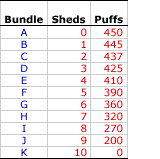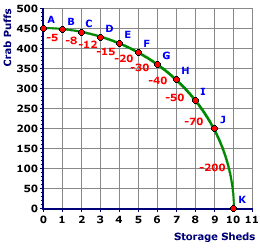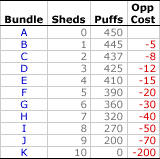
|
|
EQUILIBRIUM QUANTITY: The quantity exchanged between buyers and sellers when a market is in equilibrium. The equilibrium quantity is simultaneously equal to both the quantity demanded and quantity supplied, which means that there is no shortage nor surplus in the market. This is, in fact, the prime criterion for market equilibrium. If buyers are able to buy all of the good they're willing and able to buy (no shortage) and sellers are able to sell all of the good they're willing and able to sell (no surplus), then neither side of the market is inclined to change the existing terms of trade. And that's equilibrium.
Visit the GLOSS*arama
|
|


|

|
                           OPPORTUNITY COST, PRODUCTION POSSIBILITIES: The production possibilities analysis, which is the alternative combinations of two goods that an economy can produce with given resources and technology, can be used to illustrate opportunity cost--the highest valued alternative foregone in the pursuit of an activity. A production possibilities schedule presents alternative combinations of two goods that an economy can produce with existing resources and technology. A production possibilities curve illustrates similar information using a convex curve.A Tradeoff| Production Possibilities |  |
The production possibilities schedule presented here illustrates a tradeoff in the production of the two goods, storage sheds and crab puffs, given technical efficiency, a given technology and full employment of existing resources. Moving down the alphabet from bundle A to bundle K, the number of storage sheds produced increases from 0 to 10, but the quantity of crab puffs produced decreases from 450 dozen to 0. In other words, there is a tradeoff between the production of sheds and puffs. As more sheds are produced, fewer puffs are produced. The reason for this can be traced to the assumption underlying production possibilities analysis that resources are fixed. Because resources are fixed, producing more of one good necessarily means producing less of the other. That is, to produce more sheds, the economy must forego the production of puffs. Limited resources must be switched from puffs to sheds. Enter Opportunity CostThis sounds a lot like opportunity cost. Opportunity cost is the highest valued alternative foregone in the pursuit of an activity. The opportunity cost of producing storage sheds is the foregone production of crab puffs. Here are a few numbers to illustrate. - The opportunity cost of producing the first shed is 5 dozen crab puffs.
- As the economy moves from bundle A to bundle B, the production of sheds increases from 0 to 1 and the production of crab puffs decreases from 450 dozen to 445 dozen.
- In order to produce the first shed, the economy must switch resources from crab puff production to shed production.
- As such, 5 dozen crab puffs are given up to produce the first shed.
Using a similar process, the opportunity cost of producing the second shed can be easily determined. (Hint: It is 8 dozen crab puffs, the difference between 445 dozen and 437 dozen.) Click the [Opp Cost] button to reveal opportunity cost values for other shed production. Note that these opportunity cost values are negative, which indicates the tradeoff between sheds and crab puffs. But also note that the absolute values (ignoring the negative sign) grow larger as more sheds are produced. Slope and Cost| Production Possibilities Curve |  |
Opportunity cost is measured by the slope of the production possibilities curve. In particular, the slope of the production possibilities curve is the opportunity cost of the good measured on the horizontal axis, which in this example is storage sheds. This production possibilities curve presents opportunity cost values for segments between each pair of points. The opportunity cost of producing the first shed, moving from point A to point B is the schedule is 5 dozen crab puffs (or -5). The slope of the production possibilities curve between points A and B is also -5.Increasing Opportunity CostThe production possibilities schedule indicates that the opportunity cost of shed production increases as more sheds are produced. At the top of the schedule, the opportunity cost of the first shed is 5 dozen crab puffs. At the bottom of the schedule the opportunity cost of the tenth shed is 200 dozen crab puffs. The reason for this pattern rests with the law of increasing opportunity cost, one of the more important principles studied in economics. The law of increasing opportunity cost states that the opportunity cost of producing a good increases as more of the good is produced. The law of increasing opportunity cost results due to the third rule of inequality, which in this case means that all resources are not created equal. | Increasing Cost |  |
- The production of the first shed, moving from bundle A to bundle B, uses resources best suited for shed production and least suited for crab puffs production. As such, very few crab puffs are given up to produce one shed.
- However, as more sheds are produced, resources that are removed from crab puffs production are more suited for crab puffs production and less suited for shed production.
- With production of the tenth shed, going from bundle J to bundle K, the resources switched are those least suited for sheds and best suited for crab puffs. As such, a relatively large number of crab puffs are given up to produce one shed.
- As more sheds are produced, the opportunity cost of production increases.

Recommended Citation:OPPORTUNITY COST, PRODUCTION POSSIBILITIES, AmosWEB Encyclonomic WEB*pedia, http://www.AmosWEB.com, AmosWEB LLC, 2000-2025. [Accessed: July 18, 2025].
Check Out These Related Terms... | | | | | | | | | |
Or For A Little Background... | | | | | | | |
And For Further Study... | | | | | | | | | | | | | | | | | |
Search Again?
Back to the WEB*pedia
|



|

|
ORANGE REBELOON
[What's This?]
Today, you are likely to spend a great deal of time wandering around the downtown area trying to buy either shoe laces for your snow boots or a rim for your spare tire. Be on the lookout for the happiest person in the room.
Your Complete Scope
This isn't me! What am I?
|

|
|
The Dow Jones family of stock market price indexes began with a simple average of 11 stock prices in 1884.
|

|
|
"A winner is someone who recognizes his God-given talents, works his tail off to develop them into skills, and uses those skills to accomplish his goals. " -- Larry Bird, basketball player
|

|
PRO RATA
According to the Rate (Latin)
|

|
|
Tell us what you think about AmosWEB. Like what you see? Have suggestions for improvements? Let us know. Click the User Feedback link.
User Feedback
|


|


